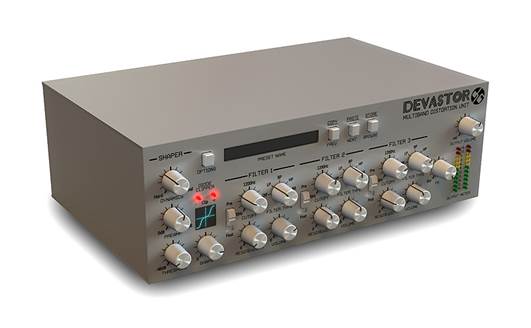FXpansion – Maul
Price: $104
Web: www.fxpansion.com
Format: VST,
AU, RTAS
Maul is a 3-stage distortion processor that
can operate in three modes Multiband, Serial and Single. Multiband puts the
three stages in parallel; Serial, as you can imagine, puts them one after the
other; and Single leaves just one stage active. Significantly, the multiple
bands are independent, as each band has individual width and limits, so bands
can overlap completely or not at all.

Maul
is a 3-stage distortion processor that can operate in three modes – Multiband,
Serial and Single
The core distortion characteristics for
each stage are selected from 32 algorithms, including everything from clip and
overdrive to ring modulation and some rather cool DCAM-sourced components (GE
Diode, JFET, Transistor and so on). Processing level is controlled by the main
Drive knob, and this is supplemented by a further switchable Saturation option.
The drive processing is topped and tailed
by the Dynamics and Tome controls respectively. Dynamics is a pre-processor
transient shaping option that can adjusted between shorter and sharper (Bite)
and longer and gentler (body). Tone is a post-drive filter that works in three
modes: High-, Band- and Low-Pass.
For balancing, each stage includes in and
out gain stages and dry/wet mix, and you’ll also find further stage gains in
the Master section along with global output gain and mix. Maul also uses
FXpansion’s TransMod system, allowing you to modulate parameters using two
LFOs, an envelope follower, sample and hold, or noise.
Maul is extremely easy to use and sounds
excellent. The core algorithms really are incredibly varied and capable of
quickly adding or moving varied and capable of quickly adding or removing
depth, transforming sounds in both predictable and unpredictable ways, and it’s
also useful having solo and mute options on each stage. The Dynamics control is
great for quickly changing sounds and can be automated in your DAW to great
effect. If you’re feeling short of inspiration Maul includes a bunch of
instrument-specific presets, and for purists there’s also an oversampled Hi Def
setting.
FabFilter – Saturn
Price: $164
Web: www.fabfilter.com
Format: VST,
RTAS, AAX, AU

Saturn
from FabFilter is a multiband saturation and distortion plugin with modulation,
offering up to six bands
Saturn from FabFilter is a multiband
saturation and distortion plugin with modulation, offering up to six bands. It
has 16 algorithms, which include various tube, tape, amp and saturation
options, and it’s operated using controls that ‘float’ over its frequency
analyzer window background.
Each band includes drive, frequency,
feedback, dynamics and 4-band tone controls, along with output level, panning
and wet/dry mix. Interestingly, you can pan the drive as well, applying a
stereo offset to the distortion.
Saturn launches with one band, and you add
further bands on screen as you need them. This is less hassle than it sounds,
and it really gives you the feeling that you’re constructing the sound you want
from the ground up. The distortions themselves aren’t as varied as those
offered by some of our other recommended plugins, but they do sound excellent.
Plus, if you fancy some movement, Saturn also has an excellent modulation
system, which includes an X/Y pad and configurable modulation step sequencer
(XLFO), as well as typical envelopes.
D16 – Devastor
Price: $37
Web: www.d16.pl
Format: VST,
AU

Devastor’s
three filters work in parallel, although they can also be individually shifted
to either before or after the clipper circuit
D16’s Devastor uses the same distortion
algorithm found in their TB-303 emulation, and is essentially a diode-clipping
processor combined with three multimode resonant filters. The main
input-shaping controls are Dynamics, Preamp, Threshold, Clip and Shape. The
first of these is a single-knob dynamics flattener, and this is followed by the
four controls that influence the clipping. Threshold and Preamp handle gain
into the processing circuit, while Clip and Shape influence the actual clip
curve. Clicking in the clip window selects one of the six shapes, and the Shape
control further modifies it. These settings have a bit influence on the sound
of the effect.
Devastor’s three filters work in parallel,
although they can also be individually shifted to either before or after the
clipper circuit. The filter options are low-pass, band-pass, high-pass and band
reject, and they can affect things dramatically, particularly if you stick them
on either side of the clipper circuit. High resonance settings, unsurprisingly,
add all sorts of lovely ringing artefacts. Combine all this with an extremely
competitive pricetag and you’ve got a real winner.